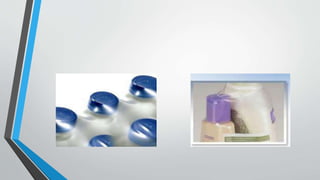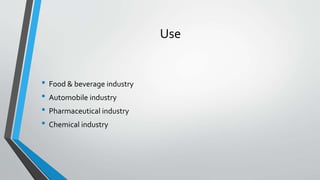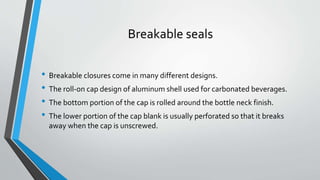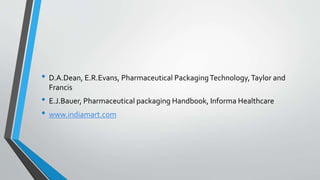Shrink packaging in pharmaceutical (foil, plastic pouches, bottle seals, tape seals, breakable seals, sealed tubes)
- 1. Shrink packaging; foil, plastic pouches, bottle seals, tape seals, breakable seals and sealed tubes Presented by : Akshay G. Trivedi Guided by : Dr. Pintu Prajapati Enrollment No : 201804103910007 Department of Pharmaceutical Quality Assurance Maliba Pharmacy College Uka Tarsadia University
- 2. Content • Shrink packaging • Foil • Plastic pouches • Bottle seals • Tape seals • Breakable seals • Sealed tubes
- 3. Shrink packaging • Shrink packaging indicates the process in which sheets of transparent plastic films are wrapped around a product to form a solid, weather – resistant packaging layer. • The shrink band concept makes use of the heat-shrinking characteristics of a stretch oriented polymer, usually PVC.
- 4. • The heat-shrinkable polymer is manufactured as an extruded, oriented tube in a diameter slightly larger than the cap and neck ring of the bottle to be sealed.The heat-shrinkable material is supplied to the bottle as a printed, collapsed tube, either precut to specified length or in roll form for an automated operation. • The proper length of PVC tubing is slid over the capped bottle far enough to engage both the cap and neck ring of the bottle.The bottle is then moved through a heat tunnel, which shrinks the tubing tightly around the cap and bottle, preventing the disengagement of cap without destroying the shrink band.
- 5. How does Shrink packaging system work ?
- 6. Benefits of shrink packaging • Shrink packaging offers a versatile, cost-effective packaging solution for several reasons. • First, the materials used (plastic derivatives) are strong yet flexible, and provide effective protection, as well as making the product temper-proof. • Second shrink packaging is transparent, making it suitable for retail and wholesale display. • Third, shrink packaging is a relatively inexpensive option.
- 7. Foil • The most commonly used shrink packaging is polyolefin. • It is available in a variety of thicknesses, clarities, strengths and shrink ratios. • Other shrink films include PVC, polyethylene, polypropylene, and several other compositions.
- 8. Foil
- 10. Use • Food & beverage industry • Automobile industry • Pharmaceutical industry • Chemical industry
- 11. Plastic pouches • A plastic pouch is a type of container made of thin, flexible, plastic film. • Plastic poches are used for containing and transporting goods such as foods, produce, chemicals, and waste. • Pouches can be made with a variety of plastics films, polyethylene is the most common.Others forms, including laminates and co-extrusions can be used when the physical properties are needed.
- 14. Uses • For Drinks and juices • Packaging of detergents and bleach
- 15. Bottle seals • A bottle may be made tamper resistant by bonding and inner seal to the rim of the bottle in such a way that the product can only be attained by destroying the seal. • For pressure sensitive inner seals pressure sensitive adhesive is coated on the surface of the inner seal as an encapsulated adhesive.
- 17. Tape seals • It involves the application of glued or pressure sensitive tape or label around or over the closure of the package which is to be destroyed to obtain the product. • Labels made of self destructing papers are available. • But these cannot survive any attempt at removal once they have been applied.
- 19. Breakable seals • Breakable closures come in many different designs. • The roll-on cap design of aluminum shell used for carbonated beverages. • The bottom portion of the cap is rolled around the bottle neck finish. • The lower portion of the cap blank is usually perforated so that it breaks away when the cap is unscrewed.
- 21. Sealed tubes • Collapsible tubes used for packaging are constructed of metal, plastic or lamination of foil, paper and plastic. • Metal tubes are still used for products that required high degree of barrier protection. • Most of these are made of aluminum. • Extruded plastic tubes are widely used for products that are compactable and limited protection of plastic.
- 23. • D.A.Dean, E.R.Evans, Pharmaceutical PackagingTechnology,Taylor and Francis • E.J.Bauer, Pharmaceutical packaging Handbook, Informa Healthcare • www.indiamart.com
Editor's Notes
- Temper proof – made so that it cannot be interfered with or changed.
- Polyolefin – it is made from the olefin propylene.
- Beverage – a drink other than water.
- Self destructing - destroy itself by exploding or disintegrating automatically
























